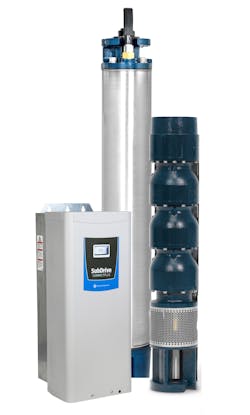Maximize Pumping with Permanent Magnets
By Brandon Schumm, Franklin Electric
As natural and human resources get stretched, the need for equipment that runs efficiently has become more critical than ever. This is especially true in pumping systems, where consistent and reliable water management is essential. Efficient solutions can often deliver positive financial benefits and yet still provide the reliability—including steady operation and consistent performance—that’s needed.
Permanent magnet (PM) motors have been in use for decades, and their higher efficiency operation is bringing their performance benefits to the spotlight. PM rotors require no electrical power, making them more efficient, especially at reduced speeds and partial loads. PM motors operate more efficiently using rare earth magnets that perform with no slip. This translates into lower input power for the same output power, saving on operational costs every time the motor runs. Also, lower current means that specific components of the system—including variable frequency drives (VFDs), motor cables and filters—might result in smaller size requirements and, consequently, become less costly.
The advancement and use of variable speed technology within the pumping industry coupled with the benefits provided by PM motors means contractors can trust that this solution will provide cost-effectiveness and efficiency.
PM Motors Perform in Submersible Applications
A PM motor in a submersible pump may lead to lower total cost of ownership (TCO), more efficient operation, better performance and less downtime. Consider:
- PM motors run with an efficiency rate of about 90 to 94 percent.
- PM motors deliver strong performance across a range of speeds for longer motor life and strong overall performance.
- PM motors operate with no slip. Their speed is constant regardless of load, delivering consistent water distribution at all times.
- When paired with a pump in submersible installations, PM motors offer high efficiency operation and speed.
- PM motors, of the same diameter and horsepower, can weigh 30 to 40 percent less than then their induction motor counterpart.
Peak Efficiency
According to field trial data for PM motors, typical high-duty rate systems can have a payback of one to two years. Paired with a VFD, a system can optimize performance and maximize system life while relying on real-time monitoring, protection and customizable application-specific programming software as needed to cover customer and building requirements. These efficiency savings also position owners and operators for the future. Energy efficiency across a broad range of operations and infrastructure-related equipment is continuing to be prioritized at both the national and local levels. PM motors assure energy-saving benefits to meet compliance considerations now and as regulations evolve.
A Broad Spectrum of Speeds
Select VFDs have been enhanced to seamlessly be paired and perform with PM motors. In the past, variable frequency for these types of installations frequently led to an intimidating and complex setup process; now, new solutions have been engineered to deliver ease-of-use. It's not only easier to upgrade from a traditional system to one that is compatible with PM technology for more efficient operations, but it’s also a less involved process to set up a VFD overall.
VFDs are the most popular electronic device used to vary the speed of a pump and for good reason. A PM motor paired with a VFD delivers energy savings and advanced speed control. An induction motor will run at the slip speed at its rated voltage (ie. ~3,460 rpm for 60 Hz). If you try to increase the speed of an induction motor above 60 Hz, it will run in a weakened field, thereby lowering your efficiency. In contrast, PM motors have no slip and are designed to run with a synchronous speed at their rated voltage. This means users are not compromising speed for efficiency. When running a PM motor with a VFD, users can enhance and expand the pump operating range by gaining optimized efficiency.
Last but not least, when a pumping system runs with PM motors, users not only experience a higher peak in efficiency but over a larger range of horsepower (hp), allowing users to cover various ranges without needing to stock dozens of different motors. This reduces inventory, overhead and costs.
Installation & Maintenance
One final, often overlooked, benefit is the ability of PM motors to work in complex applications where submersible pumps are preferred. For example, if a user is installing a pump in a misaligned well, a submersible pump is typically the better solution, which will experience wear, tear and reduced longevity. Does a user need high flow from a reduced diameter borehole? Submersibles are typically operated at higher speeds since the pump and motor are close coupled, enabling them to move more water with a slimmer diameter pump. This changes the pump size and therefore can offer the opportunity to drill a smaller borehole for the installation of the smaller diameter pump and motor.
Brandon Schumm is the product manager for large submersible motors at Franklin Electric. He previously worked in the gearbox industry specializing in sales, marketing and product development for electric drives, including permanent magnet motors. He can be reached at [email protected]. For more information, visit franklinwater.com.

